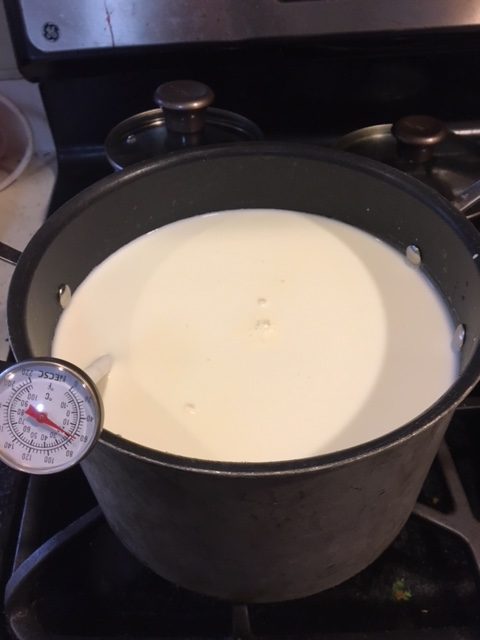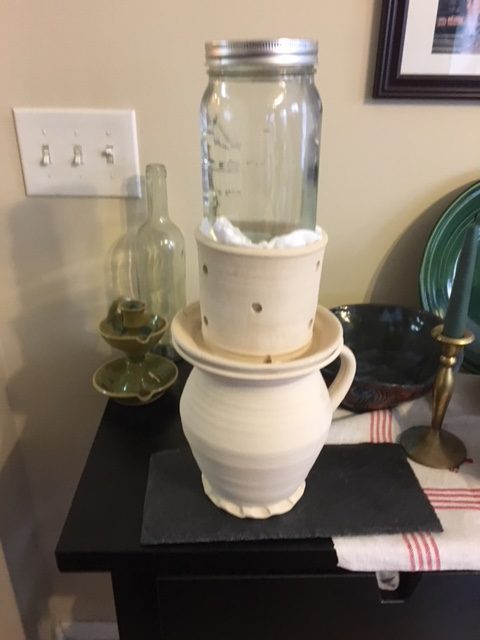
One of the things about food history that fascinates me is the origin of some of the things that we now take for granted. We accept that cheese comes in a near-infinite variety, but we don’t often think about WHY we figured out how to make cheese to begin with.
It’s because milk spoils, and it spoils really fast when you don’t have refrigeration. Cheese and butter is a way to preserve milk and reduce it down to the fatty bits. Literally today an article came across my Facebook feed from Atlas Obscura about how the Greeks and Romans considered milk-drinking to be a thing a barbarians did – which makes sense. In the Mediterranean, your milk is gonna go bad really fast. In the colder climate of Gaul or Germania, the milk will keep longer.
For a fundraiser, I put up for bid a batch of fresh cheese and an attempt at homemade butter made from milk from happy local cows (and it went for $45!). The most important thing to remember when you’re making cheese or butter is that you don’t want the milk to be ultra-pasteurized. Regular pasteurization is fine (and getting raw milk is possible but not always easy) but the ultra-pasteurization will break the proteins so they don’t come together right in the curdling process. In an ideal world, you would get non-homogenized milk as well, but that’s also not easy (and expensive). I got my milk from Appleton Farms at the Boston Public Market.
I asked: the cows are happy.
BUTTER
Now, I’ve read the Little House books, and Laura describes the basic process of making butter: you put cream into a churn or rocker, and you agitate it until the fat molecules crash together until they bond into a lump. At home, if you don’t happen to have a butter churn, you can put heavy cream into a mason jar and shake it.
And shake it.
And shake it.
Until little grains appear and then you shake it some more while it globs together and the sound changes:
AND MAGICALLY YOU HAVE BUTTER:

See it? It took about 26 minutes of shaking (based on the timestamps of the videos). Then I poured it out into a cloth to strain out the buttermilk. I think I maybe should have shook it for another minute or so. Anyway, I used cheese salt to salt it, and…yeah, I over salted it, but all I promised was an attempt at butter.

It was pretty tasty though.
SO NOW FOR THE EASIEST CHEESE. I do admit that this was totally an excuse to FINALLY use my 14th Century cheese mold:

The easiest way to make a quick cheese is to add an acid to warm milk. I used lemon juice because the taste is very mild and also I had a huge bottle of it.

USE FULL FAT MILK. Heat it up to just under 200 degrees, and stir it constantly, otherwise you get the skin on the top and it scorches at the bottom of the pan. Once it gets up to temp, add a 1/2 cup of lemon juice per gallon of milk.
Stir it, and nod approvingly at the curdling:
Then cover it and let it sit for about ten minutes:
Okay I had fun with videos this month.
Anyway, once the curds have set, you need to separate them from the whey, and press them together a bit. That’s where the cheesecloth and cheese mold come in. I put the curds into the mold and squeezed down gently, and then put a full quart mason jar full of water on top and let it sit for about half an hour.

And in the jug, you have the whey:

I am sorry that I don’t have any pictures of the finished cheese. There was a time crunch happening. But it’s a white, soft cheese with a very mild flavor that would go well with a plummy jam.
While I will, of course, be playing around more with cheese, I will not be making butter in a jar again. First, it’s cheaper just to…buy…butter? Second, if I wanted to make it, I’d just use my KitchenAid mixer instead of pretending like Shakeweights are a good idea.
But I did it! And I know what it sounds like! And now so do you!


I’ve heard many a woeful tale about cooks using the KitchenAid for whipped cream and turning it into butter, and my response has always been “And? You made butter! How many people can make that claim?!” You are a determined soul to persist with the jar.
I make “ricotta” with the warm milk and acid method because store-bought ricotta is grainy and unpleasant to me. (Scare quotes courtesy of a family member who informed me REAL cheese takes rennet and this method is just FARMER’S cheese. No, he did not get any of this farmer’s lasagna.) If you coordinate cheese making with bread baking, the whey is great for the liquid in the bread recipe. The extra protein boosts elasticity, and the acid gives it a sourdough vibe.
Yes, @Ren, I spent hours reading rants about “real ricotta” vs farmer’s cheese when I was wanting to make some cheese. Reminded me of the what is a real Anzac biscuit debate for the level of vitriol. Thank you, RHG for doing all that shaking, so that I didn’t have to. As one who has made whipped-cream-oops-butter it was interesting how difficult it looked to shake in a jar.
I’ve heard mozzerella is insanely easy to make at home and I really want to try it.
I remember making butter as a kid, while learning about early European settler life on the prairies. I think each kid shook the jar for a while then passsed it on, in parallel with another lesson or activity… because I can’t imagine a 10-11 year old shaking the jar for half an hour.
I’ve never made cheese or yogurt, they’re on my list.
@Ren Benton: I would be delighted to consume farmer’s lasagna and to brag that you made your own cheese.
In third grade for our thanksgiving celebration we made butter in baby food jars. It was the nastiest, goopiest butter ever and I still grimace thirty years on at the thought.
Some notes on cheesemaking. 1. The best curdling agent is cultured buttermilk. Lemon juice does have a flavor, which is not suitable for all purposes. 2. Don’t over-curdle or the texture gets dry and grainy. Just add a cautious amount of the curdling agent, and if it doesn’t work, add more bit by bit. 3. Do not let the bottom scorch. Even if you pour off the top part into a new pot it’ll still taste nasty. (Signed, someone who’s done numerous batches and made all these mistakes & more.)
You can also put your homemade yogurt in cheesecloth, drain it, mix in a few herbs, and call that cheese. The office enjoys it with crackers when I take it in.
The milk and lemon juice looks easy, too. Thanks for sharing. I think I will try it.
The America’s Test Kitchen DIY cookbook has a number of cheese (ricotta, which is pretty similar to what RedHeadedGirl made, plus mozzarella, feta, paneer, and goat cheese) and butter recipes, for anyone who wants a recipe to follow. It’s one of my favorite cookbooks.
I want to know where you got your cheese mold from. Not that I need any more gadgets….
I’ve made mascarpone and crème fraîche. Remarkably easy and tasty.
I got the cheese mold from a potter friend of mine who is on Etsy as That Pottery Guy (A lot of pottery I have is from him).
https://www.etsy.com/shop/thatpotteryguy
He made six cheese molds, I think? I got the last one this past winter on deep discount because he was tired of carrying it around and wanted it out of his life, and I really wanted it in mine. I do not know if he will be making more. But his stuff is amazing and you should check it out.
THANK YOU RHG!! I have spent several Easters looking for the Farmer’s Cheese my aunt used to use in her traditional Italian ham pie with no success; you just can’t get the stuff in the South. But now I know I can make my own and don’t have to settle for queso anymore!! I thank you, my kids thank you and my heritage thanks you.
I have a couple of friends with a smallholding and have made both butter and cheese with them using milk from their cows. The thing I didn’t know about butter is that if you want it to keep you have to bash the water out. It’s what butter paddles are for, you knead the butter with them (so it stays cool) until you can’t get any more water out. About as boring as the shaking to make the butter in the first place which I remember ding as a child, my friend have a hand cranked churn, a beautiful piece of kit, so that bit was easier. The getting the water out semd to go on for ever, but if you don’t do it properlyyour cheese will go mouldy quite quickly even in the fridge. Or so I was told, having made that mistake my friend wasn’t about to let me make it!
If you want to make paneer, take RHG’s chees recipe, drain it over night then shape into a rough square about 1 1/2″ deep, wrap in fresh cheesecloth, folding the ends in to confine the cheese, put it on a chopping board that you have wedged at a slight angle on your draining board, put another board on top, weigh it down with this or whatever is handy and heavy then leave it until it’s 1″ deep. Yum.
Sorry that’s all jumbled up, lack of sleep.
I remember reading about Tiffany Aching and her butter making, using the paddles Jazzlet mentioned above to remove the water, and then stamping each slab with a gibbous moon and a witch on a broomstick. Bless you, Terry Pratchett.
My mom would show her summer church school kids how to make butter. I tried, but Trader Joe’s Cultured French butter is a better reward.
It’s great to have this cheese recipe, because I sometimes have a hard time finding farmer’s cheese, and it’s pretty pricey. I use it to make fruit dumplings, like my grandmother used to make. I mix a small package of farmer cheese with one egg, and add a bit of baking powder and enough flour so the dough can be handled without sticking to you fingers. Then you take a small ball of dough(about a ping-pong ball’s worth) and shape it around a small apricot or Italian plum(look for the smallest ones when you buy them). Make sure the dough is well sealed around the fruit. Then you drop the balls in boiling water, when they float to the top they’re done. To serve, brown some breadcrumbs in butter, and roll the dumplings in that, sprinkle with sugar and cinnamon. I think this is a Czech-Austrian recipe, but there are other versions.
@Ren, great idea to use the whey for making bread! I’m going to try that too.
I’ve made cheese (mozzarella) with my chemistry students in class – they especially liked the kneading part at the end to make “stringy” cheese! It took a 45 minute class period, with everything set up to go, the help of a microwave (not traditional!), and that didn’t include clean up. But it was relatively easy, they enjoyed it a lot, and we all learned some things.
LOVE IT!!! You’ve lived my Laura Ingalls Wilder fantasy. And even better, you’ve given me an idea for my US version of the Romance Readers Guide—although given how fast the Scotland and English Country Side versions are going, l’ll be like a 100 years old before it comes out. But THANK YOU!!! Sonja
I use the kitchenaid to make butter from leftover cream
I had a pioneer-lifestyle-something book (not a story, but like a facts & trivia book) growing up that said you could make butter by hanging a bucket under your covered wagon and just letting the bumpy terrain churn your butter for you. Not sure how that would translate to modern life unless you’ve got an ancient suspension system and dirt roads, but it sure would be easier on the arms. Probably not very sanitary either, but I still kind of want to try it just to see if it would really work…
We did the “making butter in class” project too. We ended up with lumpy room-temperature whipped cream that the teachers salted and had us put on bread. Never again.
I want to make some not-ricotta now; the storebought always has some sort of plastic-y taste & I’ve never liked the idea of rennet (vegetarian, but a lazy vegetarian; I still eat it while going “hmm this grosses me out a little, but on the other hand, cheese.”)
At Easter, my grandmother always made hrutka cheese – Czech/ Slovenian in background. Her recipe used eggs as well, and she’d hang the cheesecloth- wrapped ball from the kitchen faucet to let it drip into the sink, just like this recipe. It was the best, on a slice of bread with leftover Easter ham… miss her so much.
http://www.geniuskitchen.com/recipe/hrutka-egg-cheese-174728
One of the local shops sells cheese-making supplies and offers classes, including making brie. Brie-making in the middle of nowhere! If I could get a pottery cheese mold out of it, I may have to take up my friend’s invitation to take a class with her.
RHG – I always enjoy the gratuitous pottery porn in your Historical Kitchen posts! I now feel I am lacking a cheese mold in my collection.
We recently made cheese for our biotechnology class (our group made cheddar and cream cheese) and while it was pretty cool, where on earth does one get rennet in real life? Anyway, it’s nice to know that, if I ever get the urge to make cheese again, there are other methods
You can order rennet from cheesemaking.com and I’ve even gotten it from Amazon. Rennet is easy to find.
For butter making, you have to have good quality full cream or double thick cream i.e. with all the fat still in the cream.
I used “fresh cream” from a smaller dairy that was usually low cost and it didn’t turn into butter, instead I got the poorly whipped cream thing. When I paid more for the fresh cream from another dairy, it churned up well and was delicious!
Guess the first dairy was cheaper because they *skimmed* from the cream instead of the milk. Must’ve been using it in another product.
I’ve also done the butter from a shaken jar exercise, both as a student and as a teacher. To get something that resembles butter as we know it, you really do have to rinse it and squeeze the excess whey out.
I’m wondering if it’s possible to make cheese with an immersion circulator to get it to exactly 200 degrees and keep it there?
@Ruth: Umm… if you HAVE an immersion circulator, use it in absolutely everything you can!
I just use a candy thermometer clipped to the side of the pan to get to 200, then take the pan off the heat, dump in the acid, and let it sit without further cooking.